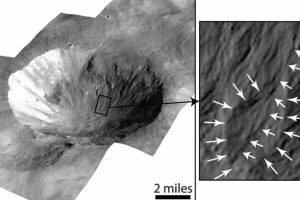July 18 () –
Canadian and Chinese scientists have described an unusual fossil from about 125 million years ago that captures the moment when a carnivorous mammal attacked a larger herbivorous dinosauras published in the magazine ‘Scientific Reports’.
“The two animals are locked in mortal combat, intimately intertwined, and it is some of the first evidence demonstrating actual predatory behavior of a mammal on a dinosaur.“, explains Dr. Jordan Mallon, paleobiologist at the Canadian Museum of Nature and co-author of the study.
The presence of the fossil calls into question the view that dinosaurs were hardly threatened by their mammalian contemporaries during the Cretaceous, when dinosaurs were the dominant animals. The rare fossil is now in the collections of the Weihai Ziguang Shi Yan School Museum in China’s Shandong province.
The dinosaur in the well-preserved fossil is identified as a species of Psittacosaurus, about the size of a large dog. Herbivorous psittacosaurs are among the earliest known horned dinosaurs and lived in Asia during the Late Cretaceous, between 125 and 105 million years ago.
The mammal of the fossil couple is a badger-like animal, called ‘Repenomamus robustus’. Although not large compared to dinosaurs, it was one of the largest mammals in the Cretaceous, at a time when mammals did not yet rule the Earth.
Before this discovery, paleontologists knew that Repenomamus fed on dinosaurs, including Psittacosaurus, thanks to fossilized bones of the herbivore’s hatchlings found in the mammal’s stomach.
“The coexistence of these two animals is not new, but what is new to science thanks to this amazing fossil is the predatory behavior it showsMallon adds.
The fossil was collected in the Chinese province of Liaoning in 2012, and both skeletons are almost complete. Their integrity is due to the fact that they come from an area known as the Liujitun fossil beds, which have been dubbed ‘China’s Dinosaur Pompeii’.
The name refers to the numerous fossils of dinosaurs, small mammals, lizards, and amphibians in the area., animals suddenly engulfed en masse by mudslides and debris following one or more volcanic eruptions. The existence of volcanic material in the rocky matrix of the study fossil was confirmed after analysis by Dr. Aaron Lussier, a mineralogist at the Canadian Museum of Nature.
The Psittacosaurus-Repenomamus fossil was in the care of study co-author Dr. Gang Han in China, who brought it to the attention of paleobiologist Xiao-Chun Wu of the Canadian Museum of Nature. Wu has been working with Chinese researchers for decades and knew it was special as soon as she saw it.
Close examination of the fossil pair shows that the Psittacosaurus is lying upside down, with the hindlimbs folded on either side of the body. The Repenomamus’s body coils to the right and it sits on top of its prey, with the mammal grasping the larger dinosaur’s jaw.
The mammal also bites into some ribs and the hind leg of the Repenomamus latches on to the hind leg of the dinosaur. “The weight of evidence suggests that an active attack was taking place.”says Dr. Mallon.
Mallon, Wu and their colleagues ruled out the possibility that the mammal was simply scavenging a dead dinosaur. For example, the dinosaur’s bones bear no tooth marks, suggesting that it was not being scavenged, but rather preyed on. AND it is unlikely that the two animals would have become so entangled if the dinosaur had died before the mammal pounced on it. The position of the Repenomamus on top of the Psittacosaurus suggests that it was also the aggressor.
Analogies of smaller animals attacking larger prey are known in the modern world. Mallon and Wu note that some solitary wolverines have been known to hunt larger animals, including caribou and domestic sheep. And in the African savannah, wild dogs, jackals and hyenas attack still-living prey, which collapses, often in shock.
“This could be the case of what is depicted in the fossil, in which the Repenomamus ate the Psittacosaurus while it was still alive, before both died in the tumultuous crash.Mallon explains.
The research team speculates in their paper that volcanic deposits from the Lujiatun fossil beds in China will continue to provide new evidence for species interactions otherwise unknown in the rest of the fossil record.










![[Img #74150]](https://thelatestnews.world/wp-content/uploads/2024/10/Che-Guevara-revolutionary-and-scientist-They-disseminate-details-of-their-300x200.jpg)
